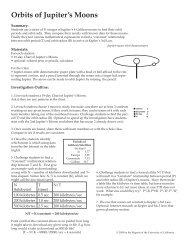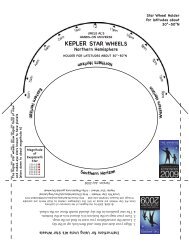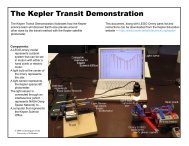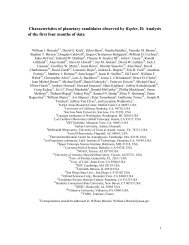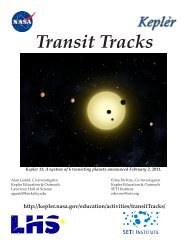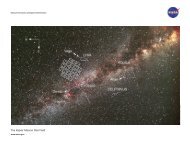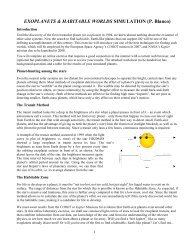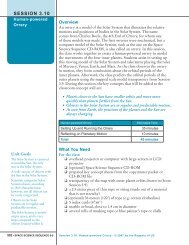Poster Abstracts - Kepler - NASA
Poster Abstracts - Kepler - NASA
Poster Abstracts - Kepler - NASA
- No tags were found...
Create successful ePaper yourself
Turn your PDF publications into a flip-book with our unique Google optimized e-Paper software.
POSTER ABSTRACTSP0110. POSTER SESSION IVETTING KEPLER PLANET CANDIDATES WITH MULTI-COLOR PHOTOMETRY FROM THEGRAN TELESCOPIO CANARIAS. K. D. Colón 1 , E. B. Ford 2 , R. C. Morehead 3 , M. Shabram 4 , 1 Department ofAstronomy, University of Florida, 211 Bryant Space Science Center, PO Box 112055, Gainesville, FL 32611;knicole@astro.ufl.edu, 2University of Florida; eford@astro.ufl.edu, 3 University of Florida;rmorehead@astro.ufl.edu, 4 University of Florida; mshabram@astro.ufl.edu.Introduction: We present multi-color observationsof several planet candidates recently identified by the<strong>Kepler</strong> space mission [1]. By applying the unique capabilitiesof OSIRIS (installed on the 10.4-meter GranTelescopio Canarias) for near-simultaneous multi-colorphotometry, we use the color of <strong>Kepler</strong> candidates asmeasured during predicted transit events to reject candidatesthat are false positives (e.g., a blend with aneclipsing binary either in the background or bound tothe target star). Because a majority of <strong>Kepler</strong>’s eclipsingbinaries have short orbital periods [2,3], and becausehierarchical triple star systems can mimicNeptune-size transits [4], we specifically target smallplanets (less than ~6 Earth radii in size) with short orbitalperiods (less than ~6 days). Our results includethe identification of KOI 225.01 and KOI 1187.01 asfalse positives. These observations are part of a programto observationally determine the false positiverate for a subset of <strong>Kepler</strong> planet candidates (i.e. planetswith radii less than ~6 Earth radii and orbital periodsof less than ~6 days) and are complementary to asimilar program being conducted using warm-Spitzer[e.g., 5,6,7]. The results of this program will be comparedto recent estimates made for the false positiverates for the <strong>Kepler</strong> sample [4,7]. This material isbased upon work supported by the National ScienceFoundation Graduate Research Fellowship under GrantNo. DGE-0802270. This work was also aided bygrants from the American Philosophical Society andthe National Geographic Society.References: [1] Borucki W. J. et al. (2011) ApJ,736, 19. [2] Prsa A. et al. (2011) AJ, 141, 83. [3] SlawsonR. W. et al. (2011) submitted to AJ,arXiv:1103.1659. [4] Morton T. D. and Johnson J. A.(2011) ApJ, 738, 170. [5] Ballard S. et al. (2011) acceptedto AJ, arXiv:1109.1561. [6] Fressin F. et al.(2011) accepted to AJ, arXiv: 1105.4647. [7] DesertJ.-M. et al. (2011) Bulletin of the AAS, Abstract#211.06.1202011 <strong>Kepler</strong> Science Conference - <strong>NASA</strong> Ames Research Center



